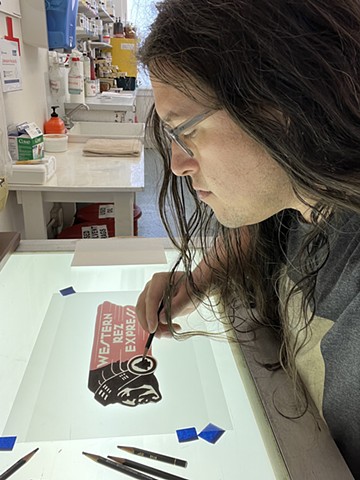ARTIST STATEMENT

Much of my art practice since 2010 has focused on reinterpreting traditional Karuk basketry designs into monotype prints. I develop my compositions by pairing and layering geometric tribal patterns with organic shapes that reference landscape elements, like mountains or water. When approaching a new series, I begin by looking at historical baskets for inspiration. A traditional basket starts with the gathering and preparation of materials. It can take a year of collecting and processing before any weaving takes place. I think about the people who made them, the knowledge that was passed down from previous generations, and the time and effort that brought these baskets into existence. Each basket tells a unique story and is a memory from a way of life that has existed since time immemorial. I envision each individual print, painting, drawing, or mural I make as its own story that will have its own unique lifetime.
Since 2020, I have also been engaging with a new body of work that combines items and/or beliefs from traditional Karuk culture with elements from contemporary designer brands such as Louis Vuitton. With these pieces I am exploring the relationship between the pre-contact Karuk cultural practices of accumulating wealth objects for increased social prestige with my modern experience as a consumer living in urban America. Regardless of their ethnicity or the times they lived, one thing that all our past ancestors have in common with everyone alive today is that we, along with everything we’ve made and consumed, come from the land.
The relationship that Indigenous people have with land is often presented as mystical, but it was built over millennia as our ancestors interacted with the natural environment. I do not believe it is wholly dependent on any specific physical location; instead, it is a way of existing in the world around us. Tommy Orange (Cheyenne/Arapaho) touched on this in his debut novel, There There, when he wrote, “Being Indian has never been about returning to the land. The land is everywhere or nowhere.”
All the work I make is a deliberate continuance of Karuk culture. Regardless of my motives while artmaking, its mere existence becomes an act of resistance against colonial assimilation. My art is made with these intentions: to thank and honor all of my ancestors, to acknowledge and heal historical traumas, and to help build new Indigenous futures.
Fox Spears